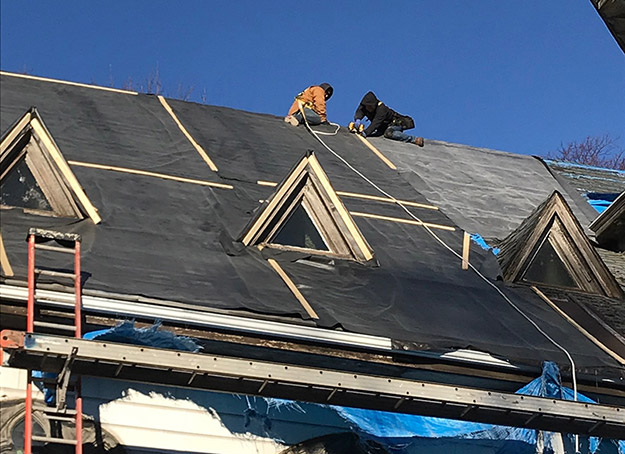
04 Jan Stabilization Work Continues at St. James African Orthodox Church
HBI recently set about protecting Roxbury’s St. James African Orthodox Church from incurring any further damage due to weather and deterioration while its rehabilitation is planned. After closing off openings in the building envelope to myriad wildlife that had begun to call the building home, our focus turned to the roof. We enlisted the help of roofer and mason Ward Hamilton of Olde Mohawk Historic Preservation to mitigate water intrusion with a temporary rubber roof. We asked Ward to tell us how rubber roofs work and his approach to installing one on the church’s complicated surface.
The asphalt shingles on the church roof were old–really old. Some sections had been replaced more recently than others, but recent is a relative term when you’re talking about a period that spans decades. Many sections had curled and cupped, the material becoming brittle and crumbling like potato chips. Others had worn and broken, revealing ancient layers of roofing beneath. And some areas of the roof had been covered with a now-tattered tarp, so old and worn that its original color was nearly indistinguishable.
Tarps are for emergencies and aren’t meant to serve as protective coverings for long periods of time. The work inside of the church isn’t going to start any time soon; further, the church’s roof is full of wonderful details and angle changes that make tarp a poor choice. Without a snug fit to the roof surface it would only be a matter of time before the winds had tattered and torn the new tarp. Fortunately, HBI had some experience in this area to draw on.

In 2012, HBI became involved in efforts to preserve the ca. 1875 Malcolm X / Ella Collins-Little House in Roxbury. Like the African Orthodox Church, the roof system had several significant failures that were allowing water to infiltrate and destroy interior finishes. It would be some time before the roof could be restored–longer than a tarp would hold up–and a solution was needed quickly. Olde Mohawk installed an EPDM roof as a stop gap measure.
EPDM (ethylene propylene diener monomer) rubber is typically used in low-sloped roofing applications and its seams are joined by “peel and stick” cover tape. At 4.5 mm thick, the rubber membrane roofing offers more durability than a tarp. Cut to size and tacked to the roof with furring strips, the various shapes and sizes needed to cover the numerous planes of the roof are joined with the seam tape. The finished product is a more sustainable and effective way to provide short- and medium-range protection of the interior.

To measure the roof, Olde Mohawk uses EagleView Technologies to generate a fast and accurate measurement report. Using Google Earth satellite images, EagleView uses a proprietary engineering program called Ptolemetry to generate the report. The EagleView report features detailed 3D diagrams, calculations of roof lengths, pitch, and square footage and includes a summary page with waste calculations. The result is an accurate measurement of the roof at a fraction of what it would cost a roofing crew to gather the same data.
Olde Mohawk’s roofing crew just completed the rubber roof installation last week, just ahead of winter weather. The temporary roof will last three to five years.




